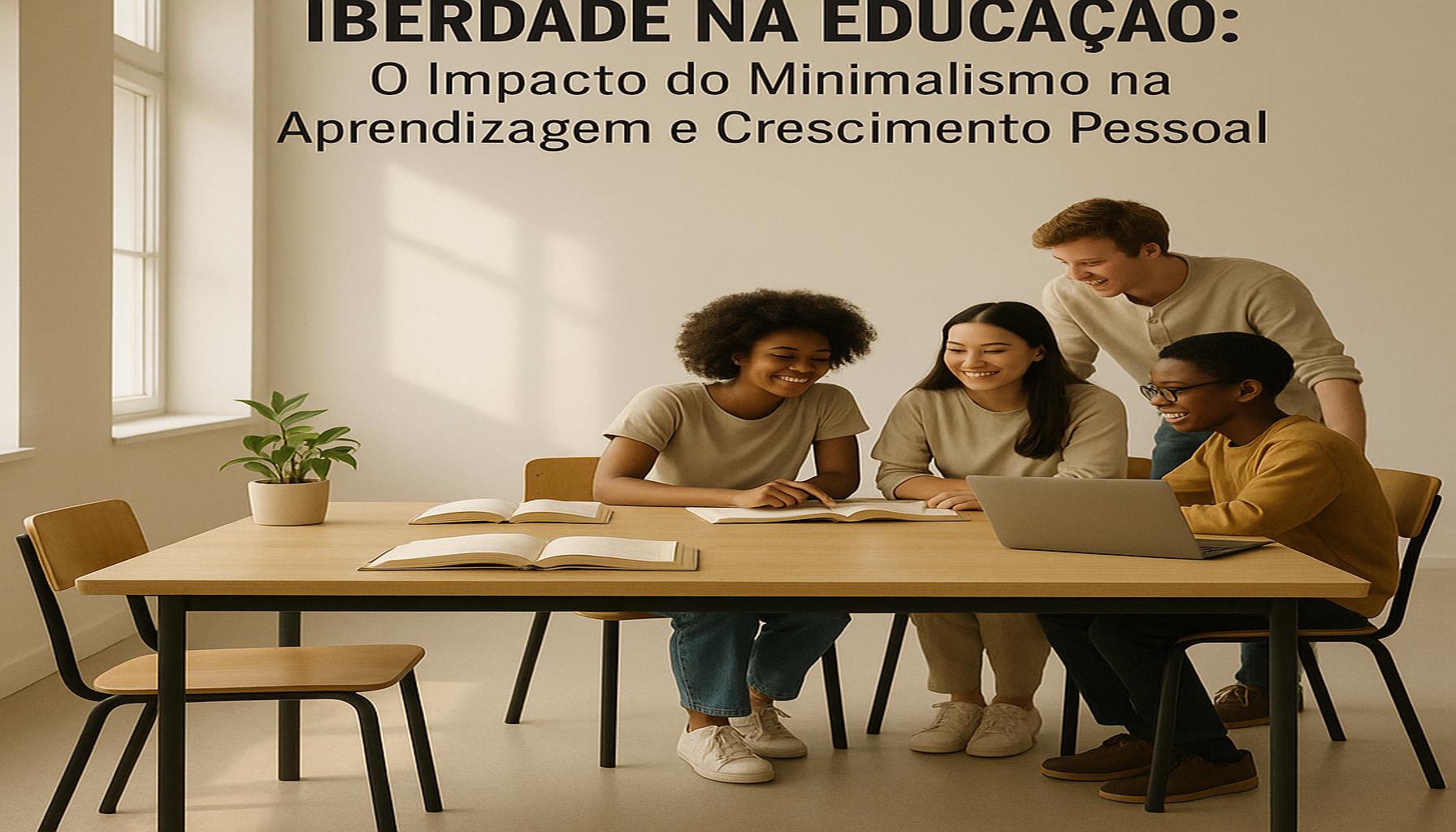Freedom in Education: The Impact of Minimalism on Learning and Personal Growth

Understanding Minimalism in Education
In an age where information overload is the norm and students are inundated with a myriad of tasks, the idea of minimalism presents a refreshing alternative. This approach emphasizes a stripped-down philosophy centered on valuing quality over quantity in educational experiences. The premise is simple: by reducing distractions and narrowing the focus, students can achieve deeper understanding and engagement.
Curriculum Design is one of the most vital areas where minimalism can take root. Traditional education often attempts to cover vast amounts of content, leaving students overwhelmed and underprepared. In contrast, a minimalist curriculum prioritizes essential concepts, encouraging students to dive deeper into fewer subjects. For instance, instead of cramming history lessons from multiple epochs into a semester, educators might focus intensively on one crucial period, like the Civil Rights Movement, fostering a richer understanding of its significance and impact on modern society.
Furthermore, Learning Environments play a critical role in facilitating minimalist education. Classrooms that are free from unnecessary clutter not only enhance concentration but also spark creativity. For instance, adopting flexible seating arrangements or using technology, such as interactive whiteboards, can create dynamic spaces for collaborative learning. Schools that embrace openness and simplicity often see an increase in participation and enthusiasm among students.
The assessment landscape also benefits from minimalism through Assessment Techniques that focus on mastery rather than rote memorization. Traditional testing often prioritizes immediate recall of information, which can inhibit critical thinking. By adopting performance-based assessments, like projects or presentations, students engage with material more deeply. For example, students may be tasked with creating a documentary on a social issue, promoting not only research and analytical skills but also collaboration and communication.
Research supports the idea that fewer distractions lead to higher student engagement and motivation. Studies have shown that students exposed to minimalist educational practices report a greater interest in their subjects and improved academic performance. This approach nurtures essential skills like critical thinking and problem-solving, laying the foundations for lifelong learners.

As education continues to transform across the United States, the implications of adopting a minimalist approach are significant. By removing unnecessary clutter and focusing on what truly matters, educators can empower students, preparing them for a future that values depth over breadth. The journey toward minimalism in education is not just a trend; it is a potential turning point that promises to enhance the learning experience for generations to come. As we move forward, the ongoing exploration of this philosophy will likely unveil new strategies and methodologies that further enrich the educational landscape.
DISCOVER MORE: Click here to learn how minimalism can transform your space
The Role of Mindfulness in Minimalist Education
One of the most compelling aspects of a minimalist approach in education is its alignment with the principles of mindfulness. Mindfulness encourages an acute awareness and presence that can dramatically improve students’ ability to absorb and engage with material. In classrooms that promote minimalist teachings, students are often encouraged to reflect on their learning processes, cultivating a sense of awareness that extends to their personal growth.
Implementing mindfulness as a core element of education fosters a learning environment where students become stewards of their own educational journeys. Instead of simply navigating through textbooks and tests, students learn to focus on understanding concepts and applying knowledge in real-world contexts. This shift enhances their capability to retain information and apply critical thinking in practical scenarios, a skill increasingly sought after in today’s job market.
Practical Applications of Minimalism in Classroom Settings
Educators looking to incorporate minimalism can explore a variety of strategies that streamline the learning experience. Here are a few practical applications:
- Reducing Material Clutter: Simplifying classroom decor and limiting the number of educational resources allows students to direct their attention toward meaningful tasks and projects.
- Focus on Core Values: Teachers can prioritize core values such as collaboration, creativity, and critical thinking over traditional metrics of success, leading to a more holistic educational experience.
- Integrative Learning: Incorporating interdisciplinary studies promotes connections between subjects, enabling students to see their education as a cohesive whole rather than a collection of separate lessons.
- Frequent Feedback: Implementing a feedback-rich atmosphere where students receive constructive input regularly aids them in making adjustments in their learning strategies, thus promoting a growth mindset.
These strategies do not simply reduce the noise in a student’s academic life; they open up pathways to more innovative thinking and self-discovery, fundamental aspects of personal growth. By embracing a streamlined educational model, students can focus on what truly matters—mastering skills that resonate with their interests and aspirations.
Moreover, the impact of minimalism extends beyond the classroom. As students learn to prioritize and manage their educational responsibilities effectively, they gain a sense of autonomy that can enhance their overall well-being. The freedom to pursue interests unencumbered by an overload of tasks cultivates a sense of self-directedness and confidence. These characteristics are vital as they navigate their personal and academic endeavors.
In the evolving landscape of education, where digital distractions and information bombardment have become commonplace, the minimalist philosophy stands as a beacon guiding students toward thoughtful engagement and profound personal growth. By emphasizing quality over quantity, minimalism doesn’t just change how students learn; it transforms how they understand themselves and their place in the world.
| Advantage | Explanation |
|---|---|
| Enhanced Focus | Minimalism reduces distractions, allowing learners to concentrate better on their tasks. |
| Personalized Learning | A minimalist approach fosters individualized education, catering to students’ unique needs and strengths. |
| Mental Clarity | Simplifying the learning environment can lead to improved cognitive processing and retention of information. |
| Creative Freedom | Less clutter allows for more creative thinking and problem-solving opportunities for students. |
Minimalism in education encourages a profound transformation in the learning experience. By embracing simplicity, students can experience enhanced focus, leading to deeper engagement with their studies. The clutter-free environment promotes mental clarity, enabling learners to process and retain information more effectively. Furthermore, a minimalist approach nurtures personalized learning, as it allows educational methods to align closely with individual student needs.This educational philosophy not only emphasizes the importance of creativity in problem-solving but also offers a space where learners can explore their passions without the burden of excess. As more educators and institutions recognize these benefits, the potential for academic and personal growth within a minimalist framework becomes increasingly appealing. Such strategies may lead to transformative experiences in the 21st-century learning landscape.
DISCOVER MORE: Click here to find out how minimalism can enhance your happiness</p
Encouraging Critical Thinking through Simplified Learning
The impact of minimalism in education is not merely a matter of aesthetics; it profoundly influences how students engage with their learning. By embracing a minimalist framework, educators can foster critical thinking, a skill vital for navigating the complexities of modern life. Rather than overwhelming students with excessive information and resources, minimalist education encourages them to delve deeply into fewer subjects, promoting a more analytical and comprehensive understanding of the material.
For instance, the use of project-based learning—a technique well-aligned with minimalist principles—allows students to focus on a single topic, encouraging thorough investigation, collaboration, and creativity. According to the Buck Institute for Education, project-based learning not only enhances critical thinking but also increases student motivation and retention of knowledge. This alignment is particularly relevant in the United States, where a significant emphasis is placed on standardized testing and performance metrics, often at the expense of genuine understanding.
The Role of Technology in Minimalist Education
The dynamic nature of technology presents both challenges and opportunities for minimalism in education. While the digital age has led to an avalanche of information, it has also provided tools that can enhance learning experiences when used judiciously. Minimalism advocates for the careful selection of technological resources to eliminate distractions and focus on tools that genuinely support learning objectives.
- Curated Online Resources: Instead of inundating students with countless websites, teachers can create curated lists of high-quality, relevant resources that encourage deeper exploration.
- Digital Portfolios: Utilizing technology to foster digital portfolios allows students to showcase their unique learning journeys while minimizing unnecessary paperwork.
- Collaborative Platforms: Tools like Google Classroom or Microsoft Teams create streamlined communication channels, allowing for focused interactions and collaborative work without excessive side distractions.
By focusing on essential technologies that streamline learning processes, educators not only reduce cognitive overload but also promote skills such as digital literacy and responsible technology use. This approach highlights the necessity for students to think critically about the resources they engage with in a digital landscape, which is critical for their personal and professional futures.
Fostering Emotional Intelligence through Minimalism
Another often-overlooked aspect of minimalist education is its potential to foster emotional intelligence (EI) among students. By creating a serene learning environment that minimizes external chaos, students can focus on their emotional responses to various learning experiences. This is particularly pertinent in collaborative and group activities, where interpersonal dynamics play a key role in personal growth.
Educators can encourage EI by integrating mindfulness practices, such as meditation and reflective journaling, within the curriculum. These practices help students to manage their feelings and respond to challenges with resilience. Furthermore, when students are taught to express their thoughts and emotions in a constructive manner, they become more adept at navigating relationships and understanding various perspectives.
By intertwining emotional intelligence within a minimalist framework, students not only achieve academic success but also develop into well-rounded individuals capable of empathy and understanding—traits that are crucial in today’s diverse society. The alignment of minimalism with emotional intelligence creates a unique opportunity for educators to nurture future leaders who can effectively adapt to an ever-changing world.
DIVE DEEPER: Click here to gain insight
Conclusion: Embracing Minimalism for a Transformative Educational Experience
In a world where educational systems are often inundated with overwhelming information and rigid structures, minimalism in education emerges as a refreshing approach to foster both learning and personal growth. This paradigm shift seeks to liberate students from unnecessary clutter, allowing them to engage deeply with the subjects at hand and cultivate important skills such as critical thinking and emotional intelligence.
Through the strategic application of minimalist principles, educators can create environments that prioritize meaningful learning experiences over rote memorization. Techniques like project-based learning and the thoughtful integration of technology serve to enhance student engagement, ensuring that learners not only acquire knowledge but also retain it in a way that is personally relevant. Moreover, by focusing on collaboration and self-reflection, educators help students develop the emotional tools needed to thrive in a diverse and changing world.
As we look forward, it is essential for stakeholders in education—parents, educators, and policymakers—to advocate for systems that embrace minimalism, fostering freedom in education. By doing so, we empower students to become self-directed learners who possess the necessary skills to tackle the complexities of tomorrow’s challenges. The intersection of minimalism and education thus presents an opportunity to cultivate a generation that values depth over breadth, creativity over conformity, and authentic engagement over mere compliance.
In conclusion, minimalism isn’t just a trend; it’s a powerful educational philosophy that promises to enrich the learning experience and nurture growth, equipping students for success inside and outside the classroom. The journey toward a more minimalist educational approach opens doors to exploration and innovation, ultimately leading to a more fulfilling and enriching academic experience.


